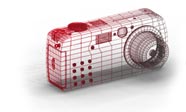Main / Photography Glossary
A | B | C | D | E | F | G | H | I | J | K | L | M | N | O | P | Q | R | S | T | U | V | W | X | Y | Z
T (setting)
Setting that holds the camera shuttle open until the shuttle dial is turned or release is press the second time. This setting differs from "B" (Bulb) that it usually is a stand alone setting and never drains the battery power and thus ideal for really long time exposures.
Telephoto Lens
A lens that makes a subject appear larger on film than does a normal lens at the same camera-to-subject distance. A telephoto lens has a longer focal length and narrower field of view than a normal lens and have a shallower depth of field than wide angle lenses. But it can do isolation of subject and have a longer reach without going near to the subject. Life can be very difficult in sports and wildlife photography. Telephoto lens whose focal length is longer than the diagonal of the film frame; in 35mm photography, lenses longer than 50-5Bmm; also referred to as a "long" lens.
T-Grain technology
Trademark for patented Kodak film emulsion technology used in all Kodak Advanced Photo System films; uniquely shaped grains that align better than conventional silver crystals, absorbing and transmitting light more effectively to produce sharper images.
Thin Negative
A negative that is underexposed or underdeveloped (or both). A thin negative appears less dense than a normal negative.
Through-the-lens (TTL).
Type of exposure meter built into the camera body and reading through the camera lens. May measure either at full aperture or at picture taking aperture. (refer below for more descriptions).
Through-The-Lens Focusing
Viewing a scene to be photographed through the same lens that admits light to the film. Through-the-lens viewing, as in a single-lens-reflex (SLR) camera, while focusing and composing a picture, eliminates parallax.
Through-The-Lens Metering
Meter built into the camera determines exposure for the scene by reading light that passes through the lens during picture-taking. Most SLR cameras have built-in meters which measure light after it has passed through the lens, a feature that enables exposure readings to be taken from the actual image about to be recorded on film, whatever the lens angle of view and regardless of whether a filter is used or not.
TTL auto flash :
The camera's light sensor measures flash illumination, as reflected by the subject on the film and shuts off the flash where measurement indicates a correct exposure. Because the sensor that controls the flash receives light through the lens TTL auto flash can be used for bounce flash photography, fill flash, multiple flash photography, etc. An additional advantage of TTL auto flash is that it enables you to use a wide range of aperture settings, while ensuring correct exposure. Time Exposure
A comparatively long exposure made in seconds or minutes.
Tint
Shades of white in a finished print, controlled by the color of the paper, varying from white to buff.
Titanium/Titan Camera Body
Titanium is one of the world's strongest, yet lightest materials; its specific grauit is approximately half that of brass, yet its hardness is almost the same as that of steel, while its corrosion resistance is greater than that of stainless steel. However, titanium is a uery difficult material to process. TLR
Twin lens reflex camera that have separate viewing and actual exposure lens. Rollei still have one in production. Tone
The degree of lightness or darkness in any given area of a print; also referred to as value. Cold tones (bluish) and warm tones (reddish) refer to the color of the image in both black-and-white and color photographs.
Toning
Intensifying or changing the tone of a photographic print after processing. Solutions called toners are used to produce various shades of colors.
Transparency
Basically, slide film. A positive photographic image on film, viewed or projected by transmitted light (light shining through film).
Transparent magnetic layer
Information storage layer built into Advanced Photo System film that enables enhanced information exchange capabilities, improving print quality by capturing lighting and scene information and other picture-taking data; basis for future information exchange features.
Tripod
A three-legged supporting stand used to hold the camera steady. Especially useful when using slow shutter speeds and/or telephoto lenses. Another is the monopod, single leg tripod.
T/S
The tilt and shift lens, Canon's version of the PC (perspective control) lens.
Tungsten Light
Light from regular room lamps and ceiling fixtures, not fluorescent. Images produced under this light source can be extremely warm, in fact excessive warmth. Need some color balance filtration or flash to neutralise that.
Type A film.
Colour film balanced for use with photolamps (3400K).
Type B film.
Colour film balanced for use with studio lamps (3200K). |

